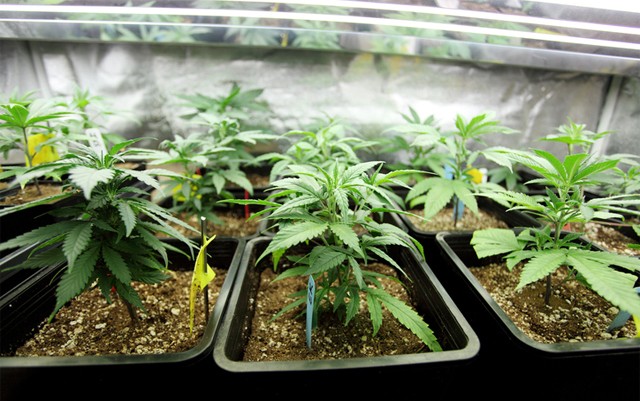Calcium (Ca), like magnesium and sulfur, belongs to the class of secondary nutrients; those substances not quite as important as the N-P-K macros, but required in much greater quantity than the so-called micro-nutrients. Calcium plays an important role in nutrient transport from the roots to the leaves and helps to build strong cell walls.
Calcium deficiency is rare in most native California soils, yet crops such as tomatoes and cannabis seem to suffer the symptoms of insufficient calcium quite often. Why is that? Mobility, depletion and availability. Unlike the previous nutrients we’ve discussed in this series, calcium is mostly immobile in the cannabis plant and cannot be scavenged from older plant parts to growing root tips and new stem or leaf cells where it is constantly required.
No one has yet published a study measuring the calcium uptake rate of cannabis, but tomatoes (whose growth habits vaguely resemble those of cannabis) use around 30 pounds of calcium per acre each season. Farmers commonly rejuvenate this depletion with applications of dolomite lime, which is also used to raise the pH levels of soil. As I pointed out in my previous article, most soils in California start out slightly basic (above 7.0) and contain an abundance of mineralized calcium and magnesium. Over time, organic fertilizers and acid rain can lower the pH to the point of locking up certain nutrients, meaning they are present in the soil but immobile, unobtainable by the plant roots due to the chemistry and physics of ionic bonds. A little bit of clay in the soil helps increase calcium availability.
Drought conditions and under-watering also induce symptoms of calcium deficiency, as can overwatering, which leaches away vital nutrients. My weird San Francisco urban debris soil is pH neutral but quite sandy; tomatoes and peppers regularly developed BER – Blossom End Rot (calcium deficiency) until I amended my garden with gypsum (calcium sulphate di-hydrate). I used gypsum instead of dolomite since I did not want to raise the pH. Dolomite and gypsum both contain around 22% calcium, but are mined products and therefore deeply offend the sensibilities of the radically green; good organic and sustainable alternatives include crushed farmed oyster shell, which is available in bulk from most hydro or farm supply stores. As a home remedy, you can pulverize clean dry egg shells in a blender and amend your soil with the resulting powder. Liquid concentrate solutions of calcium chloride that are commonly sold as fast acting calcium deficiency cures are 90% water – convenient, effective, but ridiculously expensive. Cal/mag mixtures, some with additional micro-nutrients, can correct multiple deficiencies and are a bit more economical.
I’m often asked if it is difficult to grow cannabis; I like to tell folks that if you can grow dooryard tomatoes, you can grow your own medicine. Cannabis has no fruit to rot and you might not notice the tell-tale small spots of brown necrosis on leaves until the plant has been suffering from insufficient calcium uptake for quite some time. You might consider raising a crop of tomatoes as a proving trial or companion to cannabis, acting like a canary in the coal mine indicator if laboratory soil analysis is not an economical option for your personal grow. In hydroponic operations, brownish or even black roots should set off the alarm bells to test your reservoir for pH, total dissolved solids or calcium content. Consider flushing the growing medium as well. Calcium deficient roots will become stunted and discolored even before symptoms develop on the leaves.
Any advice and opinions about the cultivation of cannabis offered by Bruce N. Goren are his own and do not represent the University of California or the Master Gardener Program.






